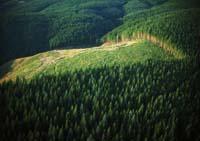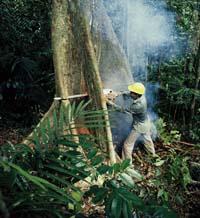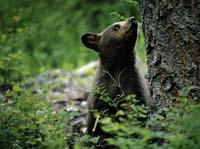Stopping the fall of forests

The total area currently occupied by forests is about 4 billion hectares. This means that 30% of the world's land is wooded and that there are 0.62 ha of forests per person. This surface, however, is very irregular. A total of 64 countries, for example, with 2 billion people, only 0.1 ha per person. And in the 5 richest countries in forests, more than half of the forests (53%): Russia, Brazil, Canada, the United States and China alone account for 20% of the world's forests. To these five countries, adding the next five, two thirds of the forests are added. And the remaining third is distributed among 212 countries. There are 7 countries or territories with no forest.
The total area, however, is decreasing year after year. Between 1990 and 2005, 13 million hectares have been cleared annually, mainly for obtaining agricultural land, without appreciating a tendency to reduce this deforestation. However, net forest loss has declined in the last five years (2000-2005).
The dynamics of forest extension are simple. There are two processes that reduce forest area. On the one hand, and above all, deforestation, that is, deforestation of the human being to give a new use to the soil, such as agriculture or the construction of other infrastructures. On the other hand, there are natural events. They can also destroy forests, and if they are not able to regenerate them naturally and are not helped, they become other lands. On the other hand, the forest area can be increased by two more processes: the planting of forestless lands and the natural extension of forests. The latter has been quite common in some European countries, due to the abandonment of agricultural land and the depopulation of the countryside. Finally, when trees are cut but replanted or regenerated spontaneously in the short term, no changes occur in the forest area.
Taking these processes into account, the FAO report estimates net forest area variation, i.e. the difference between lost forest area and livestock. According to this, although forest loss has not decreased, the benefit has increased. In the period between 1990 and 2000, net variation has been -8,9 million hectares, while in the period 2000-2005 it has been -7,3.
South America and Africa are the territories with the greatest net loss. They have lost 4.3 and 4 million hectares annually respectively in the last five years. They note that this rate tends to decrease in Africa. In South America, on the contrary, enlargement, mainly due to exhumations in Brazil. However, they believe that it is possible that these exhumations in Brazil have given too much value.
North America, Central America and Oceania also present losses, but much less: 350 thousand ha/year. Asia, for its part, lost 800,000 hectares a year in the 1990s and has radically changed its trend from 2000 to 2005, gaining a million hectares a year. This increase is mainly due to large-scale plantations in China.

Finally, in Europe, as in the 1990s, forest land has grown at a slightly lower rate.
Characteristics of forests
In addition to measuring the alteration of forest surfaces, the report has taken into account the nature of forests, classifying them by their characteristics. More than a third of forests (36%) are primary forests. These forests are made up of their own species, in which no significant human effects are seen and ecological processes are not affected. The largest extensions of this type of forest are found in South America, the Amazon, and in North America, Central America and Russia are in a fairly high proportion. On the other hand, more than half of the forests (53%) are altered natural forests, regenerated naturally with their own species, in which human influence stands out; 7% are semi-natural forests, formed by planting or planting of native species; and 4% are forest plantations, foreign species and, in some cases, own crops or plantations.
Decreases the surface of altered primary and natural forests, increasing seminal forests and forest plantations. Since 1990, 6 million hectares of primary forests have been lost annually and there is no indication that this rate will descend. This rapid loss is not only due to deforestation: selective cuts and other human activities transform the primary forest and move to the category of transformations. Currently, primary forest loss rates are stable in most territories, except in North Africa and especially in South America, where it is growing.
However, in some European countries and in Japan data indicate that primary forest has increased. In these cases, the disruption of human activities in altered natural forests has caused human footprints to disappear over time and these forests have become primary.
Finally, the area of forest plantations is growing at a growing rate. In the last five years, 14 million hectares have been planted, 2.5 hectares annually. However, they do not reach 5% of the total surface. Plantations are made for different purposes and can be classified into two types: productive and protective. The first ones are mainly dedicated to obtaining wood and fibers, representing 78% of the plantations. The remaining 22% is intended for land and water protection.

Shade protection of trees
In relation to this protective function, the importance of forests for nature conservation is known, both to preserve biological diversity and to protect water and soil. Since 1990, the role of preserving ecological diversity has been attributed to 96 million hectares of forests. And currently the surface with this function is 11%. One of the objectives of forest management is that 25% of forests play this role.
In terms of water and soil protection, its functional surface has been increased by 50 hectares in the last 15 years. A total of 300 million hectares of forests aim to protect water and soil.







